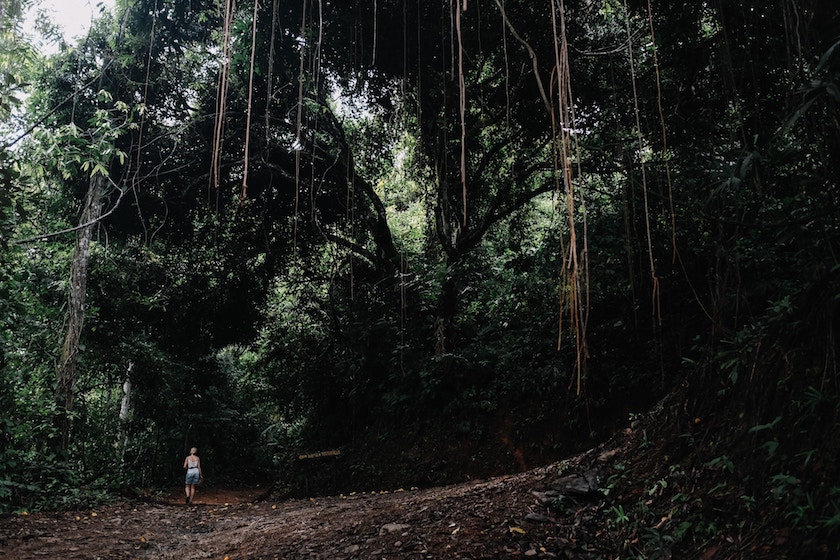The two most popular ways to explore the Bolivian jungle are “the pampas tours” – where you travel on a boat along the river, watch wildlife, and then sleep in cabins with facilities – and “the jungle tours” – where you walk in the jungle, but also stay in comfortable lodges. But there’s one more option – going wild! And that’s exactly what I did a few months ago. It was the most fun and badass travel adventure of my life – a five-day survival trip to the jungle on the Amazon basin in Bolivia.
It all went down like this: I met a girl in , who did one of the pampas tours, and one of her guides there mentioned that he could take people to the jungle for a survival experience. Little did I know what that really entailed, but I whatsapped him immediately.
A few days later I flew on the tiniest aircraft to Rurrenbaque, a little jungle town of endless tropical rain. Valdemar – my survival guide and a real jungle man – turned out to be a short, strong indigenous man around 40 years old. We made a plan to stay in the jungle for 5 days, spending the first night in his indigenous hidden community village.
The next morning we took a speed boat along one of the Amazon smaller rivers and found ourselves in Valdemar’s community. It’s a very small indigenous group called Takana. They speak Takana dialect, and their main source of income is gathering and selling bananas. I spent one day and one night there, eating bananas, grapefruits, mangoes, chocolate and coconuts straight from the trees. As it was Valentine’s Day, I decided to do a little activity with the kids at the village school. It was quite a bit of a challenge, because the kids ran in and out of school as they pleased, but I ended up making some “I love you” hearts from colored paper with some of them.
The next day we set off to the depths of the jungle: Valdemar and I, each carrying a giant machete and some very basic equipment. What did we have with us? One bottle of water (!), the rest we’d get from the river and cook on fire. He forgot the water pills, so I was a little paranoid, but all turned out well. For food we had about ten plantains, some flower, oil, a little rice, and for the last breakfast he surprised me with canned apricots. That’s it! We ate twice a day (breakfast and dinner), mostly deep fried plantains or simple pancakes, tea from jungle herbs and one time he fished. You’d think that there’re fruits all over the jungle, but no, just cacao fruits – everything else is cultivated.
Valdemar speaks only Spanish, a local Takana dialect, while I don’t speak much Spanish at all. His spelling was all over the place, so my dictionary didn’t help much either. And yet, we never stopped talking throughout the five says – the power of human communication is amazing!
We spent our days walking the jungle; up and down giant hills, chopping our way through the jungle with our machetes. Valdemar showed me his “signature” route, which only he knows, and where he had built a few basic platforms to spend the nights. I tried to remember the direction we came from, but it was impossible – all I could see was the terrifying woods where everything looked the same. It still amazes me how he was able to navigate so precisely.
The Bolivian jungle is full of jaguars and leopards, snakes such as giant anacondas and boas, endless insects – and as you walk, every branch and vine looks like it could be one of them. Along our trail I saw traces of giant snakes and at night Valdemar heard sounds of jaguars and other animals sneaking by our mosquito nets – which by the way, were the only thing that separated us from them. Who needs a tent in the jungle? Not a true survival girl! I slept with a flashlight in one hand and a machete in the other, jumping up at every noise I heard for the first few hours of the night, staring in the darkness as I thought I had heard some rustle. The jungle is so alive at night, so loud, exploding with strange noises.

On day three it started raining and it wouldn’t stop for 12 hours straight. We got soaked to the bone without protection when hiking. It was foggy in the forest, which was spooky and beautiful at the same time. When it wasn’t raining, it was hot and humid. You can cool down in the rivers of which there are plenty. The only issue is that you’ll be sharing your bath with animals and snakes. Oh, what a rollercoaster the jungle is!
Valdemar taught me how to watch out for jaguars and boas, what to do if you encounter them, how they sound and so on. I still think of jaguars a lot when I go to bed these days. Whatever troubles I may have in life now – being surprised by a jaguar at night is certainly not one of them. It shifts your perspective for sure.
What does a jungle adventure cost?
One day with Valdemar was 400 Bolivianos ($55). For two people – it would be 300 each, for a group of three – 200 each. Valdemar is investing some of the profits back into his Takana community, to work on building eco-lodges and providing basic medical education for the villagers. Together we’re currently developing a way for volunteers to come in and spend some time with his community – if you’re interested in volunteering or doing a similar survival trip, get in touch with me (details below)!
What to bring?
Take as little as possible. One set of hiking clothes is enough, since you’re going to be wet and dirty either way. Wear long sleeve shirts and long pants for sure, and a wide-brim hat. Good waterproof/resistant hiking boots are a must and I also had rubber boots, which I was super happy about. You definitely need a rain cover for your backpack, a rain jacket or poncho. Sunglasses won’t hurt and a warmer shirt or jacket will keep you warm during the night. Also bring a pocket knife, a first aid kit, a head lamp, sunscreen, and bug repellent (I had a natural oil). For the nights bring a thin sleeping bag (or one of those liners), a thermo mat and a mosquito net.
Going solo or in a group?
While I think this survival trip would have been fun with a group of friends, I’d never trade my very own one-on-one experience with Valdemar. It was so raw, and while I was almost always on the edge, it was so much fun and pure at the same time.
As we stepped out of the jungle and saw other people again, I sighed with relief. Yet, I couldn’t speak or function “normally” for a little bit. I was under such a strong impression from the jungle and its power, and there was so much to process. Although nothing specifically terrible happened to me, being in that situation and embracing it definitely pushed some new buttons and expanded the limits of what, for me, is possible.
If you’re intrigued to learn more, please watch the movie that I made about this trip, as I document every day as we go. You can view it !
 This is a guest post by Elena Zubareva.
This is a guest post by Elena Zubareva.
If you’d like to get in touch with me to arrange a similar trip, message me on Instagram – . You can follow me on YouTube read more of my stories on my blog .





























